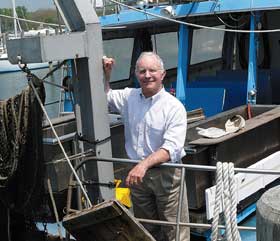  |
| HOME | THIS ISSUE | CALENDAR | GRANTS | BACK ISSUES | < BACK | NEXT > |
Professor authors guide to evaluate success of marine protected areasby Peg Van Patten - May 29, 2007 |
||||
| How do you evaluate how well a portion of the ocean is being protected? Not an easy task, but Robert Pomeroy, an associate professor of agriculture and resource economics and Sea Grant fisheries specialist, is up to the challenge. He is one of three authors who have created a 216-page guidebook to evaluate the success of Marine Protected Areas (MPAs), called How is Your MPA Doing? A Guidebook of Natural and Social Indicators for Evaluating Marine Protected Area Management Effectiveness. MPAs are critical to managing the world’s ocean resources and protecting them from human impact for a wide range of purposes. These include wildlife conservation and biodiversity, restoring depleted fisheries stocks, maximizing tourism activities, and minimizing multiple-user conflicts. But a measure of protection is effective only if it really works – that is, if it achieves the goals established for it. Every MPA is different, because each has different biota, geology, location, physical and chemical characteristics, and associated human communities that depend on the ocean’s resources. Some MPAs protect commercially important, over-exploited species from harvest, in order to facilitate recovery; others may be important spawning areas for fish or critical habitat. The guidebook, which represents the culmination of three years of work, has become the standard tool for evaluating Marine Protected Areas, not only in the United States – where it is used by NOAA’s National Ocean Service – but also in many other nations around the globe. It has been translated into Chinese, French, Italian, and Spanish, and can be downloaded in English or any of the other four languages at http://effectivempa.noaa.gov/documents/documents.html. Developing the MPA guidebook involved assessing research by experts from 17 nations. The result is a tool with specific indicators developed to measure aspects of a healthy marine environment and sustainable coastal communities. Effective evaluation, Pomeroy says, analyzes whether the actions taken have produced the desired results, rather than merely how much money was spent, what permits were issued, or how large the area protected. The socioeconomic needs of the surrounding peoples are also important to outcomes, so the manual incorporates social as well as ecological indicators of success.
|
| ADVANCE HOME UCONN HOME |

